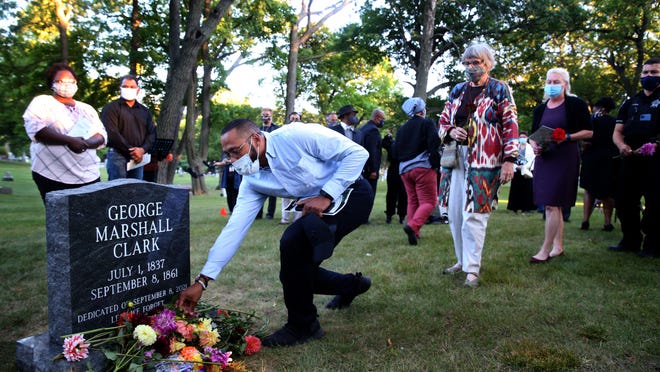La Risa R. Lynch








Early on the morning of Sept. 8, 1861, George Marshall Clark was lynched in Milwaukee and hastily buried that day in Forest Home Cemetery.
His story, and his place in history as the city's lone known lynching victim, was buried with him in an unmarked grave.
On Wednesday evening, after 160 years, and after a determined effort by a Milwaukee activist to call attention to Clark, a crowd of nearly 100 gathered to pay their respects at a ceremony to unveil a black granite headstone.
The crowd included activists, historians, community and religious leaders. They gathered at the cemetery’s Victory Garden, sitting on brown wooden folding chairs near lush green trees as a water fountain bubbled in the background.
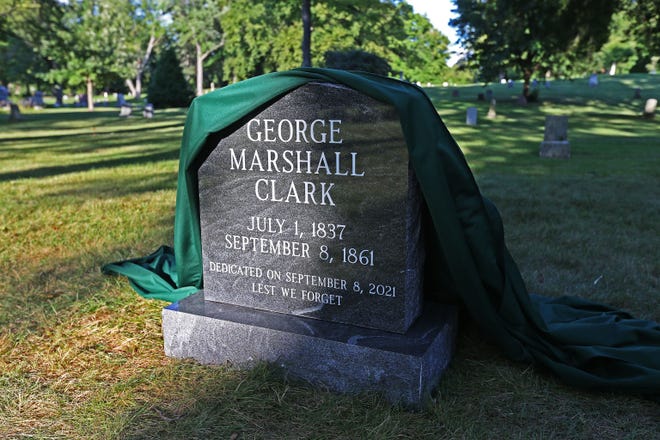
They listened. They prayed.
They remembered.
The memorial service was an amazing way to show respect, said Tyrone Macklee Randle, an artist and activist whose search for Clark's gravesite led to Wednesday's event.
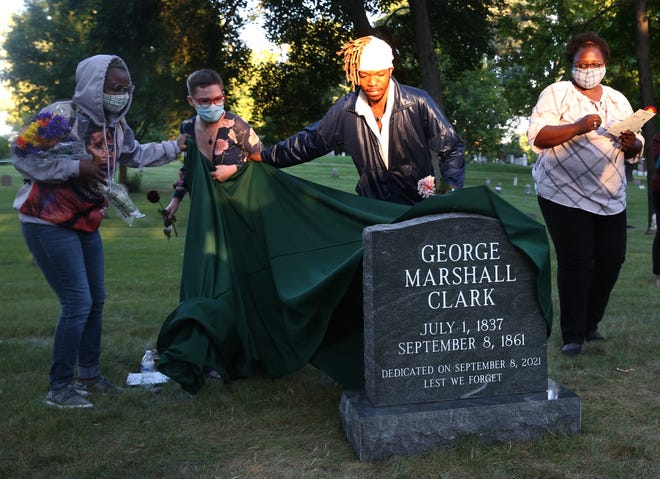
“It’s heavy," Randle said in an interview before the service began. "For a lot of Milwaukee citizens, this is a recent murder to us because we just found out about it."
The headstone, in Section 17 of the cemetery, is a simple one. It is inscribed “Lest we forget George Marshall Clark” and includes his birthdate (July 1, 1837) and the day he was killed (Sept. 8, 1861).
Wednesday's program was co-sponsored by the cemetery and America's Black Holocaust Museum, itself founded by the late Dr. James Cameron, who lived in Milwaukee for many years after surviving a 1930 lynching when he was a teenager in Marion, Indiana.
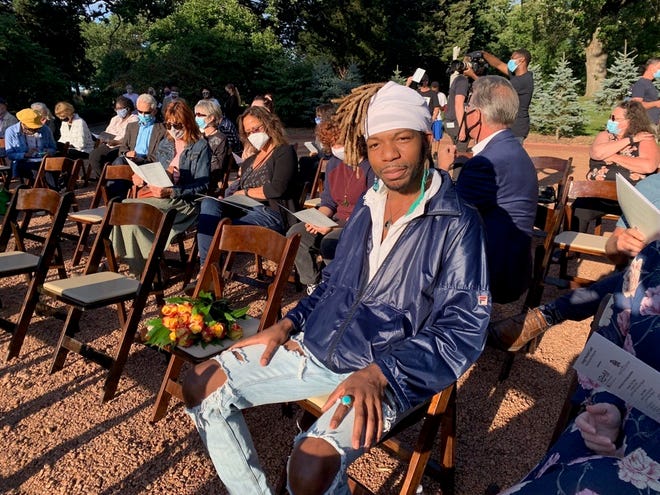
“America’s Black Holocaust Museum is uniquely positioned to help acknowledge the life of George Marshall Clark and the tragic events of his death as a charge of our mission,” Robert Davis, president & CEO of the museum, said in a statement.
“Our founder, Dr. James Cameron, dedicated his life to educating about racial violence and the terror of lynching, which he himself survived. The events of September 7 & 8, 1861 were unfortunately all too common across this nation, where lawless mobs deputized themselves and inflicted egregious harm on Black individuals and communities."
Those in the crowd on Wednesday night included Davis; the museum's griot, or storyteller, Reggie Jackson; Milwaukee County Executive David Crowley; and Ald. JoCasta Zamarripa.
But many who came were average folks, people who had heard the story and wanted to pay their respects, who wanted to assure Clark is not forgotten.
"I just think that this is really important," said Rita Flores-Wiskowski of South Milwaukee, who made a contribution toward Randle's drive to raise $4,600 for the marker. "I know it's 160 years ago that George Marshall Clark passed away but his story is just as relevant today and it really resonates with a lot of people."
Jackson noted the diversity of people who attended: "I think it is really amazing here we are 100 years later and we are about to do something that is very odd for Milwaukee. We have people getting out of their silos and collaborating on a project, particularly a project related to the types of stories we don't like to talk about."
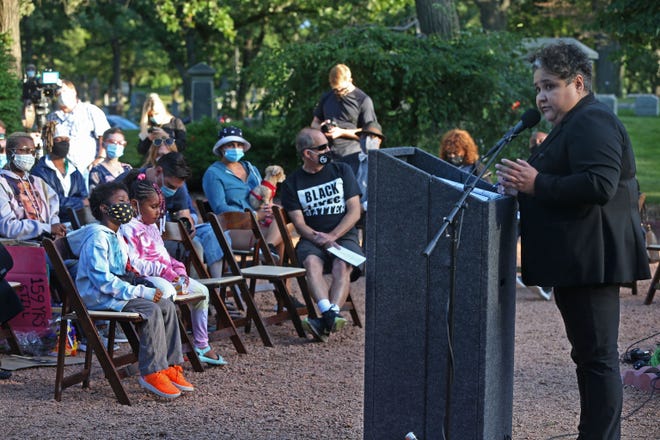
A forgotten piece of city history
Randle learned of Clark's story when doing an independent study while attending the Milwaukee Institute of Art & Design in 2014-15.
At the time, he was creating artwork inspired by the victims of police violence. A teacher mentioned, in passing, that a young Black man was lynched in Milwaukee. Randle's research led to several articles on Clark.
During a protest march last summer following the death of George Floyd at the hands of Minneapolis police, Randle was hit with police shields. As police tried to arrest him, a car ran over him, leaving him with a broken pelvis, three fractured ribs and a fracture to his spine.
As he recuperated, he remembered Clark’s story.
Clark, 24, had wanted to be a barber like his father, who was already known in the city’s Black community for his work around voting rights.
On Friday evening, Sept. 6, 1861, Clark and an acquaintance, James P. Shelton, were walking along what is now North Milwaukee Street, just south of the intersection with East Michigan Street. They came upon two white men — one a Muskego farmer, the other an owner of a Third Ward saloon frequented by Irish immigrants.
Words were exchanged and a fight broke out, according to a history written by Kevin Abing, an archivist at the Milwaukee County Historical Society. Some versions suggest two white women were the source of the argument, but subsequent descriptions, including those made by some of the men involved, mention no women.
Shelton knifed both white men and attacked a third as they were trying to disappear into the night. Police eventually found Clark and Shelton and put them in the county jail, on what is now the north side of Cathedral Square.
Darby Carney, the saloon keeper, named Shelton as his assailant before dying of his stab wounds. A crowd of 300 marched to the jail, overran the police chief and stormed inside. Clark and Shelton had been moved to a back room, and hearing the approaching mob, Shelton was able to move into a cell adjoining the back room and close the door. The mob seized Clark; Shelton escaped in the chaos.
Clark was beaten, dragged outside and taken to a nearby fire station. The crowd argued over whether it had the right man, as Clark — already beaten to the point of being unrecognizable — argued he had not knifed anyone. Eventually, the mob pronounced him guilty, dragged him to the Third Ward, and hanged him on East Buffalo Street, between what is now North Broadway and North Water Street.
Police recaptured Shelton a few days later. He was tried and acquitted for acting in self-defense, then hustled out of town for his own safety.
“George Marshall Clark died an innocent young man when his safety and dignity as a Black man were utterly denied him,” said Sara Tomlin, assistant executive director of the cemetery. “As Milwaukeeans, we owe it to all young people in our community, and to the memory of Mr. Clark, to properly acknowledge this lynching.
"We cannot risk forgetting Clark’s life or death.”
For Randle, learning about Clark sparked an interest in the history of other local Black people who died forgotten. He now considers himself a grave hunter, seeking unmarked graves of the city’s earliest Black activists and politicians.
Randle said there was a caucus of Blacks in Milwaukee during the time of the Fugitive Slave Act who were doing a lot of organizing, including Martin Smith, who worked with Clark's father. Smith was part of the group of hundreds that freed former slave Joshua Glover, who had escaped to Racine, but was captured and being held in Milwaukee.
Randle is using some of the surplus money from his fundraising effort around Clark's headstone to put markers on other graves — including one for Smith. Randle noted that Smith, too, was a victim of racial violence. He was killed by his wife’s nephew and brother, who were white.
“I was surprised to find out someone was lynched here in the first place," Randle said, in comments ahead of the ceremony. “I didn’t expect this to turn into this but I’m hoping that it catches more fire.”
Randle was intrigued to learn about these Black leaders and activists who played a very important role in Milwaukee's burgeoning Black community. This, he said, is something that needs to be talked more about, especially in school. He wants to use this as an educational piece that focuses on the city's Black heroes that no one really knows about.
“I feel like the work is still not done, but I am also really excited that this part of the mission is complete," he added

In 1861, George Marshall Clark was lynched, buried and forgotten. He finally has been honored with a ceremony, headstone in Milwaukee.
https://www.dailyadvent.com/gb/news/3fe65470eb0f39c30c6add09b5ed34da-In-1861-George-Marshall-Clark-w...
GEORGE MARSHALL CLARK AND MILWAUKEE LYNCHINGS
http://www.milwaukeeindependent.com/george-marshall-clark/

